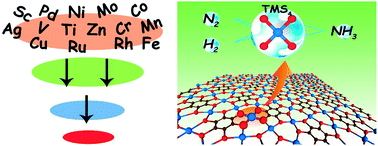Nitrogen-free TMS4-centers in metal–organic frameworks for ammonia synthesis†
Abstract
The development of two-dimensional (2D) organic catalysts with intriguing catalytic activity for the nitrogen reduction reaction (NRR) still remains challenging. Here, we exploit a series of experimentally feasible nitrogen-free metal–organic frameworks (MOFs) of transition metal–benzenehexathiol (TM–BHT, with TM being Sc, Ti, V, Cr, Mn, Fe, Co, Ni, Cu, Zn, Mo, Ru, Rh, Pd and Ag) for dinitrogen (N2) fixation and ammonia (NH3) synthesis. Through the first-principles screening and microkinetic analyses, we find that TMS4 centers can serve as electron reservoirs for associative N2 hydrogenation to overcome energy efficiency versus rate trade-offs. It turns out that among these candidates, Mo–BHT exhibits the lowest limiting potential and highest turnover frequency (TOF) competitive to that of benchmark Fe catalysts. In light of the synergistic effects between the active center and ligand, the high performance of Mo–BHT toward the NRR was rationalized. In the context of searching for efficient NRR catalysts, our results demonstrate the great possibilities of MOFs as an emerging avenue for NH3 synthesis under ambient conditions, and provide a strategy for the design of catalysts by appropriately tuning the active centers and ligands.



 Please wait while we load your content...
Please wait while we load your content...